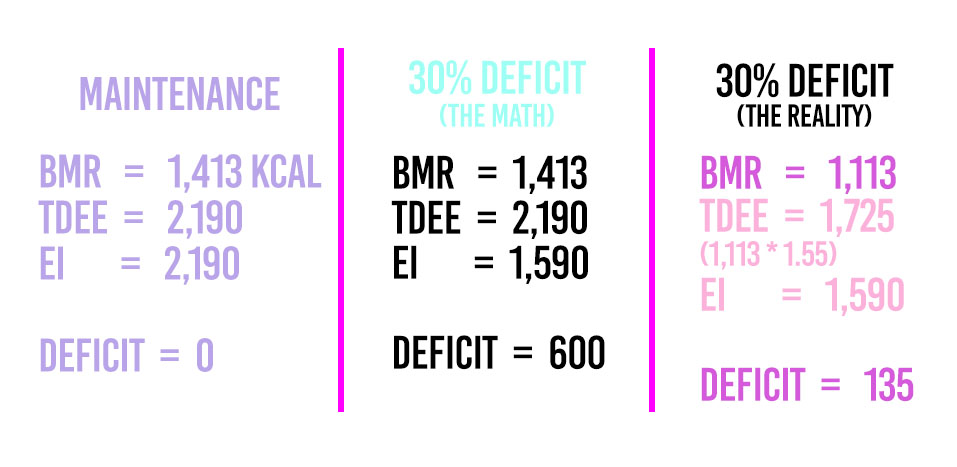
Do MORE in LESS TIME with 2 Skills
Reading Time: 5 minutes Productivity is about efficiency. Here are 2 tricks to up your game.
When you’ve been exercising and dieting but you’re not seeing results, common feedback from internet forums and gurus is that you’re not in enough of a calorie deficit.
And the thing is you believe them because even though you’ve been pretty good about tracking, there was that night last week that you grabbed some nachos out with friends and that other day when you ate a cookie with your lunch.
So you vow to be more strict about your diet and maybe even dip into more of a calorie deficit to make sure you’re staying on track.
There are 2 whopping problems with this approach. The first is that in most cases cutting more of your calories is absolutely the last thing you need to do.
Here’s how calories work. Once you see this, you’ll realize that your deficit needs to be a lot smaller than you actually think it does. And you might finally see that the bigger your calorie deficit, the slower your weight loss.
Let’s take a look.
There is a minimum number of a calories your body needs just to carry out basic functions. Breathing, small movements, brain function, that sort of thing. Basically the activities of daily living without being totally at rest. This is your Basal Metabolic Rate, or BMR. It’s calculated using the following formula:
But most of us are doing more than just shuffling around existing, so we need to also know how many calories we burn in a whole day once we factor in our activity levels. To do that, we multiply the BMR by an activity multiplier and we get our Total Daily Energy Expenditure, or TDEE. Per this paper from the Kansas State University, the activity multipliers are as follows:
Sedentary = BMR x 1.2 (little or no exercise, desk job)
Lightly active = BMR x 1.375 (light exercise/ sports 1-3 days/week)
Moderately active = BMR x 1.55 (moderate exercise/ sports 6-7 days/week)
Very active = BMR x 1.725 (hard exercise every day, or exercising 2 xs/day)
Extra active = BMR x 1.9 (hard exercise 2 or more times per day, or training for marathon, or triathlon, etc.
So by way of example, let’s look at my own BMR.
BMR = 655 + (9.6 X 63.5) + (1.8 x 176.5) – (4.7 x 36)
= 655 + 609.60 + 317.7 – 169.2
= 1,413 calories
TDEE = 1413 x 1.55
= 2,190 calories
The best thing to do here is to run with your TDEE number for a while and track your calories and activity to see if the math works out for you and your body. Or, if you’re not sure, you should always talk to a nutritionist or dietician for customized dietary advice.
Once you’ve done your calculations and you feel you’ve got a reasonable level of accuracy, you’d start looking into a deficit if your goal is fat loss.
Here’s the mind-blowing part.
A moderate, sustainable deficit to achieve about a half pound of fat loss per week is 10%. Just 10%!
In my example, my daily a ten percent deficit is just about 220 calories. Which sounds like a lot, but actually is equivalent to about one tablespoon of cooking oil and a tablespoon of peanut butter.
And those are EASY adjustments to make. And the beauty of this is that because it’s such a moderate deficit, it IS sustainable. You shouldn’t feel deprived to the point where you’re binging on weekends and making up for all the calories you denied yourself throughout the week.
Okay but then shouldn’t it also be the case that if you cut your calories more dramatically, you should lose more weight?
This is a common misconception because the math indicates that yes, that should be the case.
But your body disagrees.
Your body is really, really smart. And the way it can adapt to protect itself is pretty intense.
Let’s take the example of a 1500-calorie per day diet, which I’ve actually heard so-called nutritionists recommend to adult women, which is mind-boggling in and of itself. To make the math easier, I’ve adjusted it to 1,590kcal energy intake per day.
If we stick with the example of 2,190 kcal per day maintenance, that’s roughly a 30% deficit.

What you’d expect to happen is that your body would continue to expend 2,190 kcal worth of energy on only 1,590 kcal input, leaving you with a 600 calorie deficit and the fat loss that comes with it.
But what actually happens is your body will STOP expending 2,100 kcal worth of energy once it realizes that it isn’t being fed enough energy to cover the tab.
Remember that BMR number? We said that your body can perform all its regulatory functions for 1,413 calories per day. But when it realizes it’s not getting enough energy in the form of food to cover its essential functions and all the extra activity you’re doing, it will adapt to perform essential functions on a lower budget of, say, 1,113 calories per day. That drops your BMR by 300 calories.
Now when we multiply that BMR by the activity multiplier of 1.55, our TDEE is only 1,725kcal!
So if we’re consuming 1,590kcal per day, and our TDEE is 1,725, our deficit is actually only 135kcal. Which is actually LESS than the more sustainable 10% deficit of 210kcal that we talked about earlier.
And these numbers will continue dropping until you slowly close the gap you thought you’d created with your deficit, and you will plateau and not be losing any weight. This is a dangerous race to the bottom sort of scenario. It’s not sustainable, and it wreaks havoc on your metabolism and overall health.
The other thing to address about weight loss is to actually question whether that’s the appropriate goal in the first place.
When we see women on Pinterest, Instagram, or YouTube with a physique that we’d like to attain for ourselves, the most common thought is, “I need to lose weight.” When in fact that’s probably NOT what you need to do at all. But society and Western culture have brought us up believing that we’re fat, even when we’re not, so our automatic assumption when we want our bodies to look subjectively better is to assume that we need to lose weight.
But there’s actually a lot more going on there, and if you’re interested in what I think are the first 2 things you need to prioritize to start achieving your fitness goals, go and enjoy this video right here.

Reading Time: 5 minutes Productivity is about efficiency. Here are 2 tricks to up your game.

Reading Time: 5 minutes We all see them and want to know their secrets. Here are 5 of them.

Reading Time: 4 minutes If you’re at your wits’ end with weight loss, check this out.